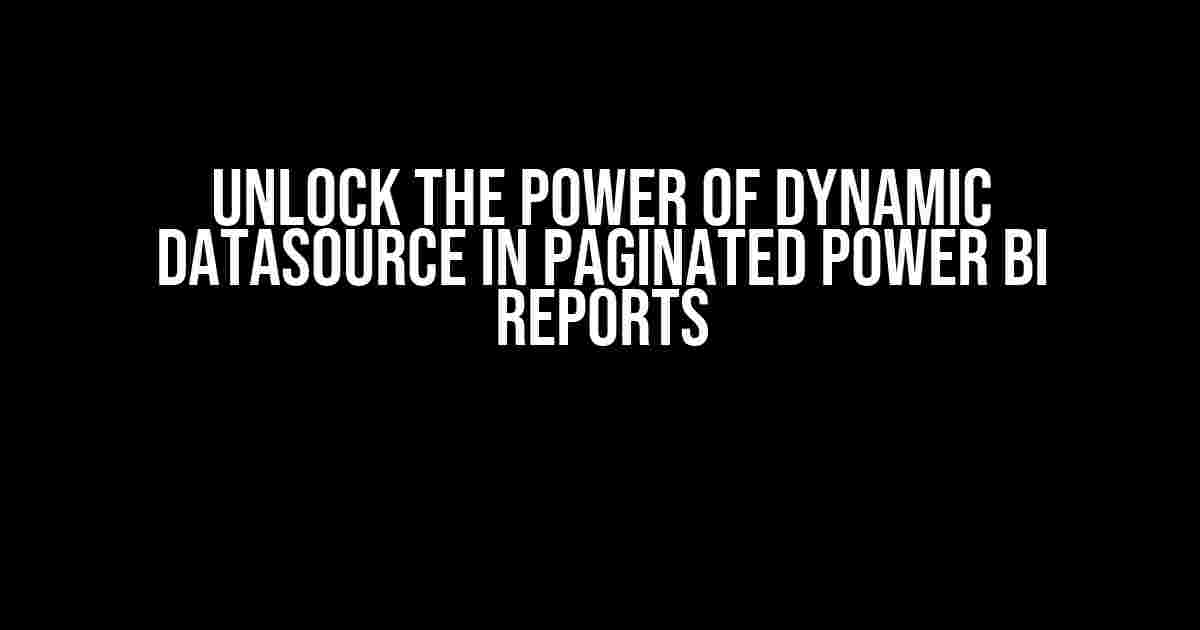Are you tired of dealing with static and inflexible datasets in your Power BI reports? Do you want to take your reporting game to the next level by leveraging the power of dynamic datasources? Look no further! In this article, we’ll dive into the world of dynamic datasources in paginated Power BI reports, and show you how to harness their full potential.
What is a Dynamic Datasource in Power BI?
A dynamic datasource in Power BI is a flexible and adaptable data connection that allows you to switch between different data sources, or modify the data structure on the fly. This means you can create reports that are more responsive to changing business needs, and provide more accurate insights to your stakeholders.
Benefits of Dynamic Datasources in Power BI
- Faster Report Development: With dynamic datasources, you can quickly switch between different data sources, reducing the time and effort required to develop and maintain reports.
- Improved Data Accuracy: By connecting to live data sources, you can ensure that your reports reflect the latest changes and trends in your business.
- Enhanced Flexibility: Dynamic datasources enable you to adapt to changing business requirements, and create reports that are more responsive to your stakeholders’ needs.
- Better Data Governance: By controlling access to data sources, you can ensure that sensitive data is protected, and that only authorized users have access to critical information.
How to Create a Dynamic Datasource in Paginated Power BI Reports
Step 1: Create a New Power BI Report
Start by creating a new Power BI report, or opening an existing one that you want to modify. Make sure you have the necessary permissions and access to the data sources you want to connect to.
Step 2: Create a New Datasource
Click on the “Modeling” tab in the ribbon, and then click on “New Datasource”. This will open the “Create a new datasource” dialog box, where you can enter the details of your data source.
{
"name": "Dynamic Datasource",
"kind": "Dynamic",
"query": "SELECT * FROM [Dynamic Table]"
}
Step 3: Define the Dynamic Datasource Query
In the “Create a new datasource” dialog box, enter a name for your datasource, and select “Dynamic” as the kind. In the “Query” field, enter the query that will define your dynamic datasource. This can be a SQL query, a Power BI formula, or even a custom API call.
SELECT
Customer.Name,
Sales.Amount
FROM
[Dynamic Table]
WHERE
Sales.Date >= '2022-01-01'
AND Sales.Date <= '2022-12-31'
Step 4: Configure the Paginated Report
Once you've created your dynamic datasource, you can configure the paginated report to use this datasource. Click on the "Report" tab in the ribbon, and then click on "Paginated Report". This will open the "Paginated Report" dialog box, where you can select the dynamic datasource as the data source for your report.
| Data Source | Dynamic Datasource |
|---|---|
| Customer | SELECT * FROM [Dynamic Table] WHERE Customer.Type = 'Retail' |
| Sales | SELECT * FROM [Dynamic Table] WHERE Sales.Region = 'North' |
Best Practices for Using Dynamic Datasources in Paginated Power BI Reports
Use Parameters to Control the Datasource
One of the most powerful features of dynamic datasources is the ability to use parameters to control the data that is retrieved. This can be done by using Power BI parameters, or by creating custom parameters using Power BI formulas.
SELECT
*
FROM
[Dynamic Table]
WHERE
Sales.Date >= ' @{StartDate} '
AND Sales.Date <= ' @{EndDate} '
Use Data Source Filtering to Optimize Performance
When working with large datasets, it's essential to use data source filtering to optimize performance. This can be done by applying filters to the dynamic datasource, or by using Power BI's built-in filtering capabilities.
SELECT
*
FROM
[Dynamic Table]
WHERE
Sales.Region = 'North'
AND Sales.Date >= '2022-01-01'
AND Sales.Date <= '2022-12-31'
Test and Validate Your Dynamic Datasource
Before deploying your paginated report, make sure to test and validate your dynamic datasource. This can be done by using Power BI's built-in testing tools, or by creating custom test scenarios using Power BI formulas.
IF
ISERROR(DynamicDatasource) = TRUE,
"Error: Dynamic Datasource Not Available",
"Dynamic Datasource OK"
Common Challenges and Troubleshooting Tips
Dynamic Datasource Not Available
If your dynamic datasource is not available, check the following:
- Make sure the data source is correctly configured and accessible.
- Check the query syntax and ensure that it is correct.
- Verify that the necessary permissions and access rights are in place.
Data Refresh Issues
If you're experiencing issues with data refresh, try the following:
- Check the data source connection and ensure it is stable.
- Verify that the data source is correctly configured and accessible.
- Use Power BI's built-in data refresh scheduling feature to schedule regular refreshes.
Conclusion
In this article, we've explored the world of dynamic datasources in paginated Power BI reports, and shown you how to harness their full potential. By following the steps and best practices outlined in this article, you can create flexible and adaptable reports that meet the changing needs of your business. Remember to test and validate your dynamic datasource, and troubleshoot any issues that may arise. With dynamic datasources, the possibilities are endless, and the insights are limitless!
Frequently Asked Question
Dynamic datasources in paginated Power BI reports can be a game-changer for your business intelligence. But, we know you've got questions! Here are the answers to get you started:
What is a dynamic datasource in Power BI?
A dynamic datasource in Power BI is a connection to a data source that can change or be updated dynamically at runtime. This allows your report to adapt to changes in your data without requiring manual updates. It's like having a superhero sidekick that keeps your reports fresh and accurate!
How do I set up a dynamic datasource in a paginated Power BI report?
To set up a dynamic datasource, you'll need to create a data source in your Power BI report that uses a formula or a parameter to determine the data connection at runtime. Then, you can use this dynamic datasource in your paginated report to fetch data from the specified source. It's like solving a puzzle, and the final piece is a flexible and powerful report!
Can I use a dynamic datasource with multiple data sources in Power BI?
Yes, you can use a dynamic datasource to connect to multiple data sources in Power BI. This is particularly useful when you need to fetch data from different sources based on certain conditions or parameters. It's like having a master key that unlocks the doors to multiple data treasures!
Are dynamic datasources in paginated reports secure?
Dynamic datasources in paginated Power BI reports are secure because they use the same authentication and authorization mechanisms as static datasources. This means that you can control who has access to the data and ensure that sensitive information is protected. It's like having a fortified castle that guards your data from unauthorized access!
Can I use dynamic datasources with Power BI Embedded?
Yes, you can use dynamic datasources with Power BI Embedded. This allows you to create custom applications that can dynamically update data connections and fetch data from different sources. It's like having a magic wand that makes your applications come alive with data!




